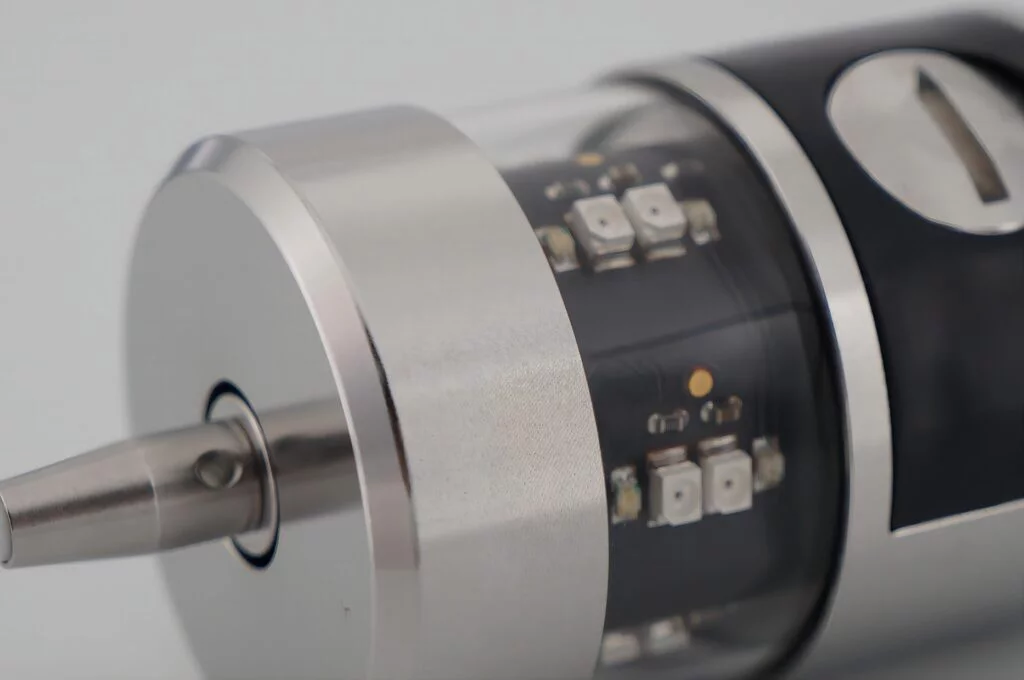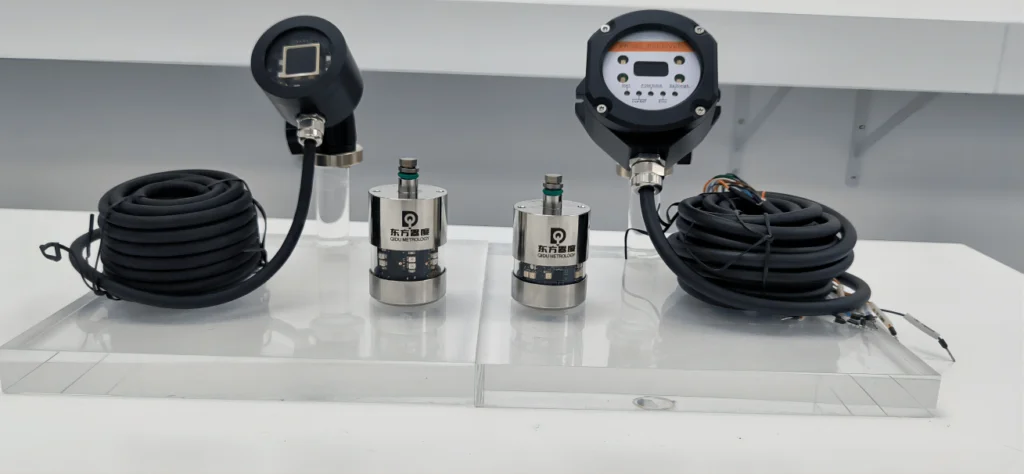Email: katrina@qidumetro.com Phone: (+86) 134 1323 8643
The Impact of CNC 3D Digitizing Probes
The world of manufacturing has undergone a revolution with the advent of CNC technology. CNC machines have transformed the way parts are produced, enabling high-precision, automated machining processes. These machines rely on digital instructions to control the movement of cutting tools, resulting in consistent and repeatable production. However, the capabilities of CNC machines can be further enhanced with the integration of CNC 3D digitizing probes.
This article delves into the impact of CNC 3D digitizing probes on CNC machining. We’ll explore how these innovative tools elevate precision, streamline workflows, and improve overall efficiency and productivity in manufacturing.
Understanding CNC 3D Digitizing Probes
A CNC 3D digitizing probe is a specialized sensor attached to a CNC machine’s tool spindle. It functions as an extension of the cutting tool, equipped with a trigger mechanism that activates when it comes into contact with a workpiece. This contact triggers a signal to the CNC controller, providing valuable data about the workpiece’s position and dimensions in three-dimensional space (X, Y, and Z axes).
In essence, these probes act as digital touch probes, capturing real-time information about the workpiece. This information can be used for various purposes within the CNC machining process, offering a multitude of benefits:
- Improved Setup and Work Offset:Precise workpiece positioning is crucial for accurate machining. Digitizing probes enable the automatic setting of work offsets, eliminating manual measurement errors and ensuring perfect alignment between the toolpath and the workpiece.
- In-Process Inspection and Quality Control:During machining, the probe can be used to verify critical dimensions and features of the workpiece. This allows for real-time quality control, identifying potential issues early in the process and preventing the production of scrap parts.
- Tool Breakage Detection:Worn or broken tools can cause significant damage to workpieces. Digitizing probes can detect changes in cutting forces that indicate tool breakage, allowing for immediate intervention and minimizing costly repairs.
- Reverse Engineering and 3D Model Creation:3D scanning capabilities of some probes allow for capturing the exact geometry of existing objects. This data can then be used for reverse engineering or creating 3D models for further design or manufacturing processes.
Enhancing Precision with CNC 3D Digitizing Probes
CNC machining is already renowned for its precision. However, CNC 3D digitizing probes take this accuracy to a whole new level. By enabling real-time measurement and feedback, these probes eliminate the need for manual setups and measurements, which are inherently prone to human error.
Furthermore, digitizing probes offer advanced measurement capabilities. They can capture data points with incredibly high resolution, often down to a fraction of a millimeter or even a micron. This level of detail ensures that CNC machines can precisely follow the programmed toolpath, resulting in parts with exceptional dimensional accuracy and surface finish.
Optimizing Efficiency and Productivity
The benefits of CNC 3D digitizing probes extend beyond enhanced precision. These tools play a crucial role in streamlining CNC machining workflows and boosting overall productivity. Here’s how:
- Llai o Amser Gosod:By automating work offset setting and eliminating the need for manual measurements, digitizing probes significantly reduce setup times. This translates to increased machine uptime and more parts produced per shift.
- Minimized Manual Intervention:The ability to perform in-process inspection and tool breakage detection with probes reduces the need for manual intervention by operators. This frees up valuable time for other tasks, leading to a more efficient workflow.
- First-Part Inspection and Reduced Scrap:Catching errors early with in-process inspection minimizes the production of scrap parts. This not only saves on material costs but also reduces overall production time.
- Improved Process Repeatability:The consistent and accurate measurements provided by probes ensure process repeatability. This allows manufacturers to maintain consistent quality throughout production runs.
Integration and Compatibility
One of the key advantages of CNC 3D digitizing probes is their seamless integration with existing CNC machines. Many probes are designed to be easily mounted on standard tool holders, allowing for quick and simple installation. Additionally, they are compatible with various CNC control systems through industry-standard communication protocols. This compatibility ensures broad applicability across diverse CNC machining environments.
Real-World Applications
CNC 3D digitizing probes have found applications in a wide range of industries, each benefiting from their unique capabilities. Here are some prominent examples:
- Aerospace Manufacturing:Precision is paramount in the aerospace industry. Digitizing probes are used for setting work offsets, verifying critical dimensions of aircraft components, and ensuring the accuracy of complex machining operations.
- Automotive Manufacturing:In the high-volume production environment of automotive manufacturing, probes come into play for automated tool setting, in-process inspection of engine parts, and robot-guided assembly tasks.
- Mold Making and Die Casting:The intricate details of molds and dies require exceptional accuracy. Probes enable precise toolpath verification
- Gweithgynhyrchu Dyfeisiau Meddygol:The delicate nature of medical devices demands the utmost precision. Probes are used for verifying the dimensions and features of implants, surgical instruments, and other medical components.
- Prototyping and Product Development:In the prototyping and product development stages, probes facilitate rapid iteration and design refinement. They enable accurate digitization of existing parts for reverse engineering and 3D model creation.
Future Trends and Innovations
The technology of CNC 3D digitizing probes is constantly evolving, with exciting advancements on the horizon. Here are some anticipated trends:
- Enhanced Sensor Fusion:Integration of multiple sensors, such as optical cameras and laser scanners, will provide even more comprehensive data about workpieces and their surroundings.
- Adaptive Programming and Real-Time Process Optimization:Probes will not only capture data but also feed it back into CNC control systems, enabling real-time process optimization and adaptive programming for even greater efficiency.
- Wireless Connectivity and Remote Operation:Wireless communication capabilities will allow for remote monitoring and operation of probes, enhancing flexibility and safety in manufacturing environments.
Common Questions
1.What are the different types of CNC 3D digitizing probes?
CNC 3D digitizing probes come in various forms, each with its own strengths and applications. Common types include:
- Touch Trigger Probes:These probes utilize a physical contact mechanism to detect the workpiece surface. They are widely used for basic setup and inspection tasks.
- Non-Contact Probes:These probes employ optical or laser-based sensors to measure the workpiece without physical contact. They are ideal for delicate surfaces or applications where contact is undesirable.
- Scanning Probes:These probes continuously capture data as they move along the workpiece surface, creating a 3D point cloud representation. They are suitable for reverse engineering and complex shape inspection.
2.How do I choose the right CNC 3D digitizing probe for my application?
The selection of the appropriate CNC 3D digitizing probe depends on several factors, including:
- Accuracy Requirements:The level of precision required for the specific application dictates the probe’s resolution and measurement capabilities.
- Workpiece Material and Surface Finish:The type of material and surface finish of the workpiece may influence the probe’s choice, as some materials or finishes may require non-contact probes.
- Application Requirements:The specific tasks the probe will be used for, such as setup, inspection, or scanning, should guide the selection.
- Compatibility with CNC Machine and Control System:Ensure the probe is compatible with the existing CNC machine and control system to ensure seamless integration.
3.What are the benefits of using CNC 3D digitizing probes over traditional measurement methods?
CNC 3D digitizing probes offer several advantages over traditional measurement methods, such as calipers and micrometers:
- Increased Accuracy:Probes provide highly accurate measurements, often down to fractions of a millimeter, surpassing the capabilities of manual tools.
- Reduced Errors:Automation eliminates human error and inconsistencies associated with manual measurements.
- Enhanced Efficiency:Probes streamline workflows by reducing setup time, minimizing manual intervention, and enabling in-process inspection.
- Improved Quality Control:Real-time data from probes facilitates early detection of errors and ensures consistent part quality.
4.How do I integrate CNC 3D digitizing probes into my existing CNC machining process?
Integrating CNC 3D digitizing probes into an existing CNC machining process typically involves the following steps:
- Probe Selection:Choose the appropriate probe based on application requirements and compatibility with the CNC machine and control system.
- Hardware Installation:Mount the probe onto the CNC machine’s tool holder and connect it to the control system’s communication ports.
- Software Configuration:Configure the CNC control system to recognize the probe and utilize its data for relevant tasks.
- Programming Modifications:Modify CNC programs to incorporate probe commands for tasks like work offset setting, inspection, and scanning.
- Hyfforddiant Gweithredwyr:Train operators on the proper use and programming of the probe to ensure optimal performance and safety.
By following these steps and carefully considering the factors mentioned above, manufacturers can successfully integrate CNC 3D digitizing probes into their operations, reaping the benefits of enhanced precision, efficiency, and quality control in their CNC machining processes.
Casgliad
CNC 3D digitizing probes have emerged as transformative tools in the world of CNC machining. Their ability to provide real-time, high-precision data about workpieces has revolutionized various manufacturing industries, leading to significant improvements in precision, efficiency, and quality control. As technology continues to advance, CNC 3D digitizing probes are poised to play an even more crucial role in the future of manufacturing, enabling even greater levels of accuracy, automation, and innovation.
Katrina
Mechanical Sales Engineer with 10+ years of experience in the manufacturing industry.Skilled in developing and executing sales strategies, building relationships with customers, and closing deals. Proficient in a variety of sales and marketing tools, including CRM software, lead generation tools, and social media. I'm able to work independently and as part of a team to meet sales goals and objectives. Dedicated to continuous improvement and learning new sales techniques.



